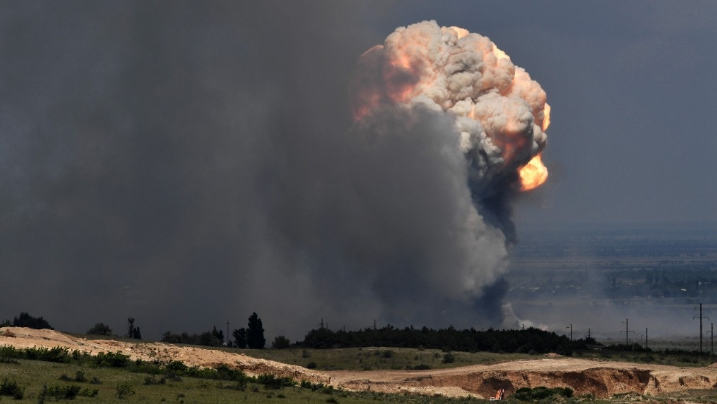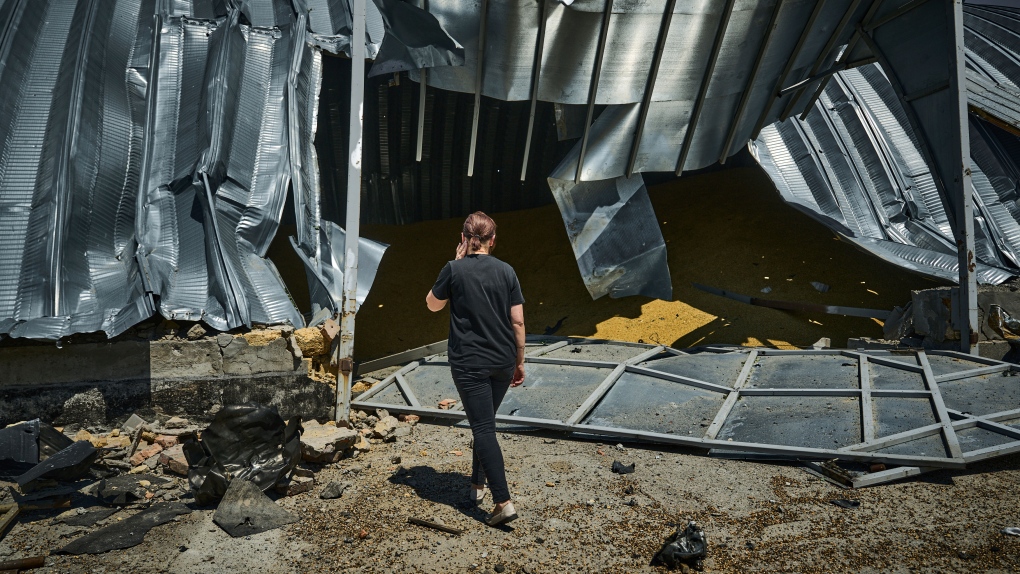
A plume of smoke rises over an ammunition depot where explosions occurred at the facility in Kirovsky district in Crimea, July 19, 2023. (Viktor Korotayev/Kommersant Publishing House via AP)
KYIV, UKRAINE –
A Ukrainian drone strike Saturday caused a massive explosion at an ammunition depot in Russia-annexed Crimea, forcing the evacuation of nearby homes in the latest attack since Moscow cancelled a landmark grain deal amid Kyiv’s grinding efforts to retake its occupied territories.
The attack on the depot in central Crimea sent huge plumes of black smoke skyward and came five days after Ukraine struck a key bridge that links Russia to the peninsula it illegally annexed in 2014 and after Moscow suspended a wartime deal that allowed Ukraine to safely export its grain through the Black Sea.
Sergey Aksyonov, the Kremlin-appointed head of Crimea, said in a Telegram post that there were no immediate reports of casualties from the strike, but that authorities were evacuating civilians within a 5-kilometre radius of the blast site.
The Ukrainian military took credit for the strike, saying it destroyed an oil depot and Russian military warehouses in Oktyabrske, in the Krasnohvardiiske region of Crimea, though without specifying which weapons it used.
A Crimean news channel posted videos Saturday showing plumes of smoke billowing above rooftops and fields near Oktyabrske, a small settlement next to an oil depot and a small military airport, as loud explosions rumbled in the background. In one video, a man can be heard saying the smoke and blast noises seemed to be coming from the direction of the airport.
The strike came during a week in which Ukraine attacked the Kerch Bridge and Russia, in what it described as “retribution” for the bridge attack, bombarded southern Ukrainian port cities, damaging critical infrastructure including grain and oil terminals.
Ukraine also attacked the bridge in October, when a truck bomb blew up two of its sections, which took months to repair. Moscow decried that assault as an act of terrorism and retaliated by bombarding Ukraine’s civilian infrastructure, targeting the country’s power grid over the winter.
The Kerch Bridge is a conspicuous symbol of Moscow’s claims on Crimea and an essential land link to the peninsula. The US$3.6 billion, 19-kilometre (nearly 12-mile) bridge is the longest in Europe and is crucial for Russia’s military operations in southern Ukraine.
Speaking at the Aspen security forum via video link, Ukrainian President Volodymyr Zelenskyy called the bridge a legitimate target for Ukraine, noting that Russia has used it to ferry military supplies and it must be “neutralized.”
In a video address to the nation later Saturday, Zelenskyy said he had a phone call with NATO Secretary-General Jens Stoltenberg to discuss “our steps to unblock and ensure the stable operation of the grain corridor” following Russia’s withdrawal from the grain deal.
Zelenskyy said they agreed to hold a meeting of the Ukraine-NATO Council in the nearest days for consultations on the issue. “We can overcome the security crisis in the Black Sea,” he said.
As fierce fighting continues in Ukraine’s bid to retake territory from Russia, Russian shelling killed at least two civilians and wounded four others on Saturday, Ukrainian officials reported. A 52-year-old woman died in Kupiansk, a town in the northeastern Kharkiv region, while another person was killed in a cross-border Russian attack on a village in the neighbouring Sumy province.
Earlier Saturday, Ukrainian officials reported that Russian attacks on 11 regions across the country on Friday and overnight had killed at least eight civilians and wounded others.
A DW cameraman was injured Saturday by shrapnel from Russian cluster munitions that also killed one Ukrainian soldier and wounded several others near the town of Druzhkivka, in the eastern Donetsk region, the German broadcaster said in a statement. Cameraman Ievgen Shylko was part of a team sent to report from the Ukrainian army training ground about 23 kilometres (14 miles) away from the frontline, it said.
“We were filming the Ukrainian army during target practice when suddenly we heard several explosions,” DW correspondent Mathias Bölinger said. “We lay down, more explosions followed, we saw people were wounded. Later, the Ukrainian army confirmed that we had been fired at with cluster munitions.”
Cluster munitions, which open in the air and release multiple small bomblets, are banned by more than 100 countries because of their threat to civilians, but they have been used extensively by both sides in the war.
The Pentagon has said the cluster munitions the U.S. recently gave to Ukraine will give Kyiv critically needed ammunition to help bolster its counteroffensive.
The Russian Defence Ministry announced that a group of Russian journalists came under artillery fire in the southern Zaporizhzhia region. In an online statement, it said four correspondents for pro-Kremlin media had been struck by cluster munitions and that one of them, Rostislav Zhuravlev of the state RIA Novosti news agency, later died from his injuries.
The Kremlin-installed head of the Russia-occupied parts of the Zaporizhzhia region, Yevhen Balitsky, claimed in a Telegram post that the journalists were travelling in a civilian vehicle that was hit by shelling. The claims couldn’t be independently verified.
Russian Foreign Ministry spokeswoman Maria Zakharova denounced the attack on journalists as a “heinous crime” in which the U.S. and its allies were complicit.
The Ukrainian air force on Saturday morning said that overnight, it had brought down 14 Russian drones, including five Iranian-made ones, over the country’s southeast, where battles are raging. In a regular social media update, the air force said that all Iranian-made Shahed exploding drones launched by Russian troops during the night were brought down, pointing to Ukraine’s increasing success rate in neutralizing them.
KYIV, UKRAINE –
Russia pounded Ukraine’s southern cities with drones and missiles for a third consecutive night Thursday, keeping Odessa in the Kremlin’s crosshairs after a bitter dispute over the end of a wartime deal that allowed Ukraine to send grain through the key Black Sea port.
The strikes killed at least two people in Odessa. In Mykolaiv, a city close to the Black Sea, at least 19 people were injured, including a child, Ukrainian officials said.
Russia has targeted Ukrainian critical grain export infrastructure since it vowed “retribution” this week for an attack that damaged a crucial bridge between Russia and the Moscow-annexed Crimean Peninsula. Russian officials blamed that strike on Ukrainian drone boats.
The strikes on Ukraine’s grain export infrastructure have helped drive up food prices in countries facing hunger. UN Secretary-General Antonio Guterres said the end of the deal Monday would result in more human suffering, with potentially millions of people affected.
The grain deal provided guaranteed that ships would not be attacked entering and leaving Ukrainian ports, while a separate agreement facilitated the movement of Russian food and fertilizer.
The Russian military on Thursday described its strikes on Odessa, a city whose downtown area is described by the United Nations’ cultural agency UNESCO as possessing “outstanding universal value,” as “retaliatory.”
In January, UNESCO added Odessa’s historic centre to its list of endangered World Heritage Sites, with UNESCO director general Audrey Azoulay saying the “legendary port that has left its mark in cinema, literature and the arts.”
Despite multiple Russian artillery attacks and airstrikes during the war that began in February 2022, Odessa had not previously been subjected to the heavy barrages that have targeted other towns and cities in Ukraine’s south and east.
Odessa residents reeled from Russia’s sudden focus on their city.
“I remember the attack on the port last year, but now it feels like it was only 5% compared to what the Russians have launched at us during these past three days,” Oleksandr Kolodin, a 29-year-old photographer, told The Associated Press.
Some feared that Russia’s decision to tear up the grain deal would make Odessa a long-term primary target.
“We saw how they could attack Kyiv for an entire month,” said 29-year-old programmer Victor, referring to the intense bombardment of the Ukrainian capital in May. He asked to use only his first name out of concern for his safety.
The Russian Defence Ministry said in a statement that it targeted “production shops and storage sites for unmanned boats” in Odessa and the nearby city of Chornomorsk. In the Mykolaiv area, the Russian military claimed to have destroyed Ukraine’s fuel infrastructure facilities and ammunition depots.
Neither sides’ claims could be independently verified.
The previous night, an intense Russian bombardment using drones and missiles damaged critical port infrastructure in Odessa, including grain and oil terminals. The attack destroyed at least 60,000 tons of grain.
In what appeared to be a tit-for-tat move, Ukraine’s Defence Ministry announced that as of Friday, all vessels in the Black Sea heading to Russian ports “may be considered by Ukraine as such carrying military cargo with all the associated risks.” That may result in higher insurance costs for those ships.
Russia’s Defence Ministry said earlier this week that Moscow had formally declared wide areas of the Black Sea dangerous for shipping and warned that it would view any incoming ship as laden with weapons, effectively announcing a sea blockade.
Despite the risks, ship owners haven’t shown any less interest so far in carrying Ukrainian grain through the Black Sea, according to John Stawpert, senior manager of environment and trade for the International Chamber of Shipping, which represents 80% of the world’s commercial fleet.
The European Union’s foreign affairs chief condemned Russia’s targeting of grain storage facilities.
“More than 60,000 tons of grain has been burned,” Josep Borrell said in Brussels on Thursday, regarding Moscow’s recent tactics. “So not only they withdraw from the grain agreement … but they are burning the grain.”
German Foreign Affairs Minister Annalena Baerbock said at the same meeting that the EU is involved in international efforts to get Ukrainian grain to the world market.
“The fact that the Russian president has cancelled the grain agreement and is now bombing the port of Odessa is not only another attack on Ukraine, but an attack on the people, on the poorest people in the world,” she said. “Hundreds of thousands of people, not to say millions, urgently need grain from Ukraine.”
The White House warned Wednesday that Russia was preparing possible attacks on civilian shipping vessels in the Black Sea. The warning could alarm shippers and further drive up grain prices.
Russia has laid additional sea mines in the approaches to Ukrainian ports, White House National Security Council spokesman Adam Hodge said in a statement. “We believe that this is a co-ordinated effort to justify any attacks against civilian ships in the Black Sea and lay blame on Ukraine for these attacks,” the statement said.
Carlos Mera, head of agricultural commodities markets at Rabobank, said wheat prices have risen about 17% over the last week, calling it a surprising rise that started even before the grain deal ended Monday and attributing it to “a little bit of panic.”
A lot of the wheat exported from Ukraine goes to very poor countries, such as those in North Africa, he said. People in those places are already struggling with food insecurity and high local food prices. Russia, meanwhile, has been exporting record amounts of wheat in recent months despite complaints that its agricultural exports have been hindered.
There is “a vast list of underdeveloped countries that depend on Ukrainian and Russian wheat,” Mera said. “And with prices going up, people will have to pay more for that wheat, which means more expensive bread in those countries.”
Russia has blasted Ukrainian towns and cities since the start of the war. Ukraine’s western allies have helped upgrade its air defence systems. The latest military aid package from the United States, announced by the Pentagon on Wednesday, includes funding for four National Advanced Surface-to-Air Missile Systems, or NASAMS, and munitions for them.

